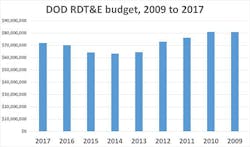Military research budget headed up for third straight year; largest seen in past five years
The fiscal 2017 DOD budget request for research, development, test, and evaluation (RDT&E) is $71.66 billion, which if enacted would be the Pentagon's largest research budget since $72.84 billion in 2012.
During the Obama Administration the Pentagon's RDT&E budget hit a peak of $80.92 billion in 2010, slid steadily to $63.1 billion in 2014, and now appears to be headed up to levels not seen in the past five years.
The fiscal 2017 DOD budget request was submitted to Congress this week. Federal fiscal year 2017 begins next October 1. Congressional committees will scrutinize the Pentagon's budget request this spring, and approve a final budget next fall.
Of particular interest in the 2017 DOD budget request for research and development is the electronics-heavy intelligence and communications account, which would rise by 13.3 percent from this year, growing from $2.97 billion in 2016 to $3.37 billion in 2017.
Related: The incredible shrinking budget for U.S. military technology research
For next year the U.S. Air Force has by far the largest proposed budget of $28.15 billion -- an 11.6 percent increase over this year's $25.21 billion. Next are defense agencies with a proposed budget of $18.47 billion -- a 2 percent drop from this year's $18.86 billion. The U.S. Navy has a $17.35 billion 2017 research budget -- down 4.4 percent from this year's $18.15 billion. Next comes the U.S. Army with a 2017 research budget request of $7.62 billion -- up less than 1 percent from this year's $7.56 billion.
Highlights of the 2017 Air Force research budget include $1.36 billion for the Long Range Strike-Bomber (LRS-B); $54.8 million for the Small Diameter Bomb; $182 million for Space Based Infrared System (SBIRS) High full-scale development; $189.8 million for inter-continental ballistic missile fuze modernization; and $32 million for anti-tamper technology.
Highlights of the 2017 Navy research budget include $126.3 million for undersea warfare applied research; $700.8 million for the Ohio Replacement next-generation ballistic missile submarine development; $100.6 million for advanced submarine systems development; $84.9 million for frigate development; and $252.4 million for offensive anti-surface warfare weapon development.
Highlights of the 2017 Army research budget include $37.8 million for command, control, and communications technology; $27.9 million for electronic warfare (EW) technology; $39.3 million for the tactical unmanned ground vehicle (TUGV); $3.6 million for anti-tamper technology support; and $91.8 million for Chinook heavy-lift helicopter product improvement.
Among the defense agencies, the U.S. Defense Advanced Research Projects Agency (DARPA) is asking for $2.97 billion next year, which would be a 3.7 percent increase from this year's $2.87 billion. Highlights of DARPA's 2017 budget request are $353.6 million for information and communications technology; $313.8 million for tactical technology; and $429 million for network-centric warfare technology.
The Defense Information Systems Agency (DISA) is asking for $251.9 million next year, which would be a 20 percent increase from this year's $209.7 million. Highlights of the 2017 DISA budget include $57.5 million for C4I interoperability; $24.5 million for global command and control systems; and $1.6 million for the Cyber Security Initiative.
The Missile Defense Agency (MDA) is asking for $5.9 billion next year, which would be a 5.2 percent cut from this year's $6.2 billion. Highlights of the 2017 MDA budget include $959.1 million for Aegis ballistic missile defense; $563.6 million for ballistic missile defense targets; and $862.1 million for ballistic missile defense midcourse defense segment.
U.S. Special Operations Command is asking for $497.2 million next year, which would be a 10.3 percent cut from this year's $554.1 million. Highlights of the 2017 Special Operations Command budget include $159.1 million for aviation systems; $44.9 million for warrior systems; and $54.6 million for maritime systems.
